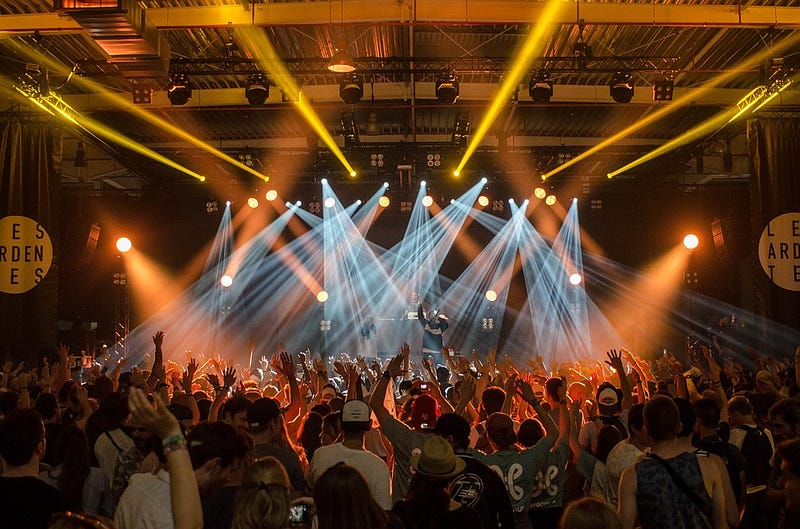Mosh Pits: A Lot of Noise
By Jennifer Garland, Applied Physics & Math, 2021

This article was originally published as part of Issue 38: People.
Metal concert attendees are familiar with deafening music, bright lights, Lovecraftian graphics, and, of course, rowdy crowds. Bands often encourage mosh pits, crowd surfing, and “walls of death,” creating a chaotic yet controlled environment that has sparked scientists’ interest. In 2013, physicists at Cornell University led by Jesse L. Silverberg published an analysis of these extreme social interactions titled “Collective Motion of Humans in Mosh and Circle Pits at Heavy Metal Concerts.”
Researchers have studied the collective motion of objects ranging from animals to bacteria to molecules and have developed mathematical models to simulate their interactions. In many biological cases, the individuals are self-propelled, meaning they use energy and give rise to a system out of thermodynamic equilibrium. The Vicsek model is widely used to describe the movement of these active agents and is famous for its simplicity and applicability to many phenomena.
In mosh pits, people bump into each other randomly, much like particles in a gas. The Cornell physicists were intrigued because while other collective human motion, such as pedestrian traffic, displays more complex behavior, mosh pits appear to fit well to the Maxwell-Boltzmann distribution, which describes the speeds of ideal gas molecules in equilibrium. However, because concert attendees are self-propelled, the group used a model similar to the Vicsek model to simulate each human mosher as a “simple soft-bodied particle [dubbed] a mobile active simulated humanoid, or MASHer.”
Over enough time, mosh pits act like gases in equilibrium, where particles move randomly and collide, despite being composed of self-propelled people.
The particles were divided into active and passive MASHers that represent different types of metal concert attendees. Active MASHers are self-propelled and subject to random fluctuations and flocking, meaning that individuals move and orient themselves with the group. Passive MASHers tend to stay still.
The researchers ran a simulation with uniformly mixed active and passive MASHers and found that the active MASHers congregated and became enclosed in a circle of passive MASHers — the setup of a mosh pit. The difference in speeds of the two types seemed to cause this development.
After a series of more simulations with varying parameters, a gas-like region appeared, mirroring observations from concert footage. The key discovery was that “both noise and collisions tend to randomize motion, whereas flocking tends to homogenize motion.” Over enough time, mosh pits act like gases in equilibrium, where particles move randomly and collide, despite being composed of self-propelled people.
When flocking (orientating with the group) was more prominent than collisions and noise, the crowd separated into a vortex instead of a mosh pit. These vortices resemble circle pits, in which people move quickly in one direction around a circle. Though a remarkable realization, a puzzling discrepancy was observed about the direction of movement around the circle pits. In simulations, clockwise and counterclockwise directions occurred evenly, and switched back and forth, but real-world data showed that 95 percent of circle pits flow counterclockwise. Possibly due to dominant footedness, the skew reveals more complexity to human interactions.
Though an unexpected subject of research, this analysis of people at heavy metal concerts provides pathways for better understanding crowds, handling emergency situations, and designing safer architecture for music venues and beyond.
Physical Review Letters (2013). DOI: 10.1103/PhysRevLett.110.228701